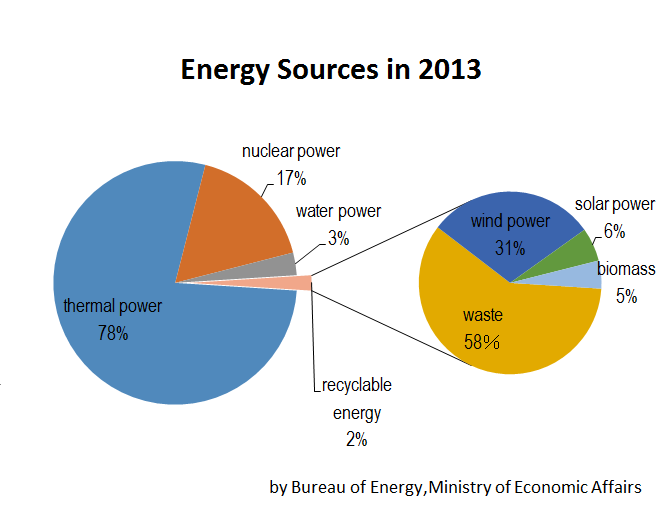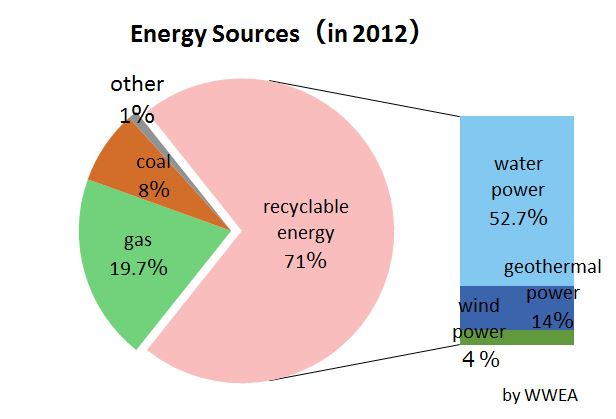Chamiko and Yuppy's Records
1.Oita, Japan written by Yuppy
・Kokonoe
The energy self-supporting rate in Kokonoe, Oita is 2323.13%. ("Sustainable Zone Report in 2015", 2015) This is the highest of all the towns and cities in Japan! There are a lot of geothermal power plants, because of many volcanoes or hot springs. The town can get heat charge by some power plants; it makes local residents' life convenient.
The population of Kokonoe is about 10,000. That of Yokohama, Kanagawa, which is largest in Japan, is about 373,000 (both in Ministry of Internal Affairs and Communications HP, 2016); the population of Kokonoe is small. A little demand for energy and high use rate may increase the energy self-supporting rate.
・Bepp
Hotel Suginoi, Bepp, has Suginoi Geothermal Power Plant. The generated electricity is used in the hotel. This is what it is like to be "local energy generation and consumption."
2.Taiwan written by Chamiko
In October 2016, I went to Taiwan as the study tour of my high school! When I visited Taiwan University and Taiwan First Girls' High School (TFG), the students there and I discussed environmental problems, especially about recyclable energy.

According to the graph, the main energy source of Taiwan is fossil fuels, and the spread of recyclable energy is not enough, so its energy circumstance is similar to Japan. Therefore, both Taiwan and Japan have two major energy problems. (1, The energy self-supporting rate is very low. 2, There is high emission of greenhouse gasses which are produced by burning fossil fuels.)

Then, we proposed "Local production for local consumption of energy".
The Taiwanese students agreed with us in that both environmental preservation and regional activation are necessary. And they proposed an idea of spreading solar power generation in Taiwan in order to solve the energy problems, probably because Taiwan is world's second-largest producer of solar panels and they are familiar for them to choose as the alternative way. However, recyclable energy accounts for only 2% of the production of electricity, and waste power and wind power generation account for its 90% in 2013. Then, in September 2014, Taiwanese government set a goal to increase the proportion of recyclable energy to 11% by 2030. Now, solar power generation is expected as an important means to reach the goal in Taiwan, because its landform and climate are suitable for solar power generation. I found many buildings with solar panels in Taipei City.
This is exactly "Local production for local consumption of energy"!


↑There are many panels on the street in front of the president palace.
I asked TFG students why the proportion of solar panel generation is still low, and they replied that this is because solar panels are not widespread among ordinary houses. In this regard, they pointed out the lack of awareness of energy problems among Taiwanese people. Though there are many supports by the government, it is no use if they don't recognize them In Japan, the number of people who are interested in energy problems has been gradually increasing since Fukushima Daiichi nuclear disaster on 3.11, 2011 but as time goes by, many people have forgotten those who have been suffering heavy damage by the disaster. I think keeping sending information like this is very important.
3.Germany written by Yuppy

Germany is environmentally-advanced country. They are going to abolish all nuclear power plants by 2025 and raise the proportion of recyclable energy to 80% by 2050. I will introduce two famous cities in Germany for their environmental policies!
 Population: 226,000 Area: 153 k㎡
Population: 226,000 Area: 153 k㎡This town has been famous as "Environmental Capital" since it got the first prize in an environmental contest in 1992. It has been a model as "Solar City", "Environmentally-advanced City" and "Green City".
When Chernobyl nuclear disaster happened in 1986, Freiburg's government decided not to depend on fossil fuels and nuclear power. In 1996, they established "Solar City Concept" to promote the use of solar power, and decided that 10% of the consumption of electricity should be generated from recyclable energy. Freiburg is suitable for solar power generation because of its warm climate and more than 1,800 hours of sunshine per year. And Feed-in tariff helped to spread solar panels. At last, 50% of the city's electricity was self-sufficiency (2010) by promoting cogeneration technologies. This city represents the concept of "local production for local consumption of energy"!
 Population: 4,600 Area: 22.49 k㎡
Population: 4,600 Area: 22.49 k㎡Through the anti-nuclear movement caused by Chernobyl nuclear disaster, the citizens established their own electric power company, and succeeded in generating energy only from recyclable energy. I think this city is so small that the citizens could unite to realize this ideal system. They were interfered by the local company, but at last they bought the electricity distribution network in 1997. In 2011, about 95% of the electricity was from recyclable energy, and the rest 5% was from natural gas! Schonau has become a model of decentralized power supply.
Also in 1998, people in Germany began to choose electric power companies by themselves by the liberalization of the electricity market. More and more people have chosen non-nuclear electricity and environmentally-friendly electricity, so a lot of people became customers of Schonau's company.
In 2011, Ursula Sladek, CEO of the company and a leader of the citizens' movement, got an award, the Goldman Environmental Prize, which honors grassroots environmental heroes from the world's six geographic regions: Africa, Asia, Europe, Islands & Island Nations, North America, and South & Central America. How powerful citizens are!
<German Environmental Consciousness Is Very High!>
I interviewed my classmate, who had an experience of studying in Germany during summer vacation.
Q.Did you feel the difference of energy policy and people's eco-friendly activities between Japan and Germany?
A.Yes, I did. Germans always try to save electricity by frequently turning off lights, and they are separating trash for recycling at schools, supermarkets and so on. Not only adults, but also children take part in such activities. I think it results from "environmental education" in Germany.
Q.What is the most impressive activity?
A.Deposit system was the most impressive. It's a system for collecting empty cans. People buy drinks with deposit money, and when they return empty cans, this money comes back. I was surprised when I bought a drink at school, and asked my host sister what the money was. She was kind enough to teach me this wonderful system.


4.New Zealand written by Yuppy
72% of energy source is recyclable in New Zealand. Compared with 5% in Japan, we can see the big gap at a glance. The graph shows you the present energy source in New Zealand.

Then, why did New Zealand succeed in utilizing recyclable energy?
★Population
The population of New Zealand is about 4.2 million. It is one-thirty of Japanese one. So, the amount of New Zealand's energy consumption is much lower, and most of them can be covered with recyclable energy. That is why the rate of recyclable energy is high in the country.
★The climate and wind power generation
New Zealand is located at latitude 30 to 40 degrees south. In the area, the wind called westerlies blow hard all years around. Having such features, the average "Load Factor" of wind power stations is over 40% there. "Load Factor" is the rate of the real amount of power generation in the amount of power generation if the facilities work 100%. In Japan, the "Load Factor" of wind power generation is said to be 20% on the land and 30% on the sea.
To sum up, in New Zealand, over 40% of the wind power can be changed to electricity, and the people living there use wind power generation without high cost. The wind power plants can get many consumers without the subsidy even though the market of the electricity has a competition to get consumers. The government declared "We will make 90% of the energy source be recyclable by 2025."


★Consciousness
New Zealand environmental consciousness is very high and the country succeeded in utilizing recyclable energy. I interviewed one of our acquaintances, who had an experience of studying in New Zealand for about a month.
Q.Did you feel the difference of energy policy and people's eco-friendly activities between Japan and New Zealand?
A.Yes. They seemed to try to coexist with the nature. Especially they payed attention to the way of using water.
Q.How did they pay attention to it?
A.There was a rule. People are allowed to use shower for only 10 minutes. If they break, the last person must use cold water, or even cannot take a shower. The rule was not made by the government or local community but every house had its own rules.
Q.Oh, that's surprising. I understood the people there are so conscious of eco-friendly actions. What else have you noticed?
A.There were switches on electrical outlets. They seldom used air-conditioning. Moreover, children there often played outside, for example, going to parks and camps, so that they can be in close contact with nature.
Q.I see. That reminds me of my experience in Australia. When I went to Australia as a student last summer, my host mother said to me, "Let's go to bed early because it is cold." The words were very impressive. We Japanese are using air-conditioning without thinking of environment. I think we must know that there are a lot of people who are very conscious of environment like them.
A.You are right. In New Zealand, not only teenagers like us, but also much younger children take it for granted that they live with consideration for the earth's environment. Seeing their life, I realized that I wasted energy a lot.


